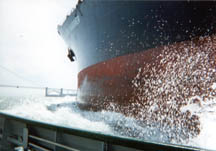 |
| Crew
Members and Captain of working tug |
The Andrew Foss is aided by
its cycloidal propulsion system, instead of the more traditional
rudder and propeller blades of most boats and many tugs. Envision
two large eggbeaters sticking into the water, blades moving in a
breast stroke fashion, near the middle of the ship’s hull. This
system invests the tug with great maneuverability which can be
critical if the tug has to make tight turns either in assisting
others to "parallel park" at a crowded dock, or for
preventing disaster. On the outbound trip the captain demonstrated
this system as he made the tug perform a few water wheelies. The
299-ton tug spun like a ballerina. Also fascinating was the fact
that the tug could easily go in reverse at up to 80% of its forward
speed of roughly 12 knots (13 mph). Engineer Mike Port was
responsible for making sure that the tug’s 4000 hp engine was in
top shape and could rise up to 900 rpm when necessary. In addition
to more traditional ways of clocking and tracking usage of various
parts of the engine, he also utilized the more advanced tool of lube
oil spectral analysis to make sure that engine parts were not being
worn down.
The sea was calm and the
visibility was generally superb. By the time we neared Mile Rock the
captain had radioed to the Marine Exchange and others, to let them
know we had arrived and were waiting. He had consulted his ship
finder, showed me maps on the computer, pointed out the radar, a fax
machine - the wheelhouse had a number of high tech tools.
 |
| Alongside
an oil
tanker |
Then we saw it coming out of
the mist. All 150,000 dead weight tons of oil tanker. It had already
picked up its Bay pilot and was heading towards us. Tanker – tug
radio conversations ensued. Our first maneuver (okay –
"their" first maneuver) was to gallop alongside the tanker
(tricky in heavy seas), as if it were a freight train, and we were
the horse and rider. And we were going stern first.
CONTINUE